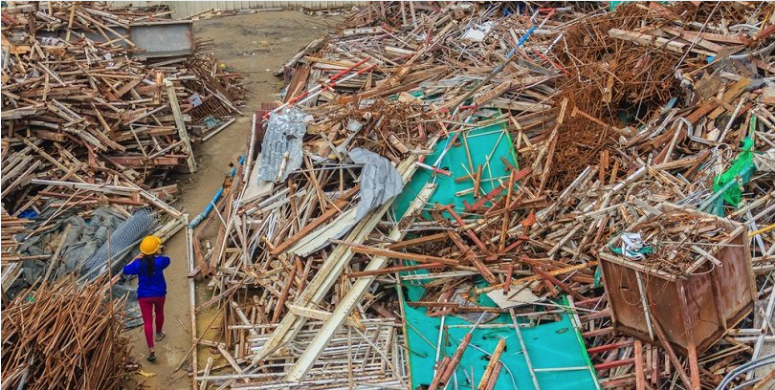3 Ways Cold-Formed Steel Slashes Construction Waste (and Costs)

Waste is a growing concern in the construction industry, posing significant risk to the environment. In 2014 alone, 534 million tons of construction and demolition (C&D) debris were generated in the U.S. — more than twice the amount of municipal solid waste generated that year.
But the effects extend to a building owner’s budget and profits, too. In general, the more waste a project produces, the less profitable it will be, considering the price paid for unused materials, as well as the cost of waste handling.
Building with cold-formed steel (CFS) framing offers a solution that addresses these concerns. The Steel Recycling Institute confirms that steel is the most recycled material on the planet — more than all other materials combined. Steel retains an extremely high overall recycling rate, which, in 2014, stood at 86 percent. The metallurgical properties of steel allow it to be recycled continually with no degradation in performance, and from one product to another.
CFS is also an efficient building material, as evidenced by its high sustainability rating. According to the Steel Framing Alliance, CFS is positioned to meet the highest sustainability standards. Steel is recognized in all major green building standards and rating programs, including the National Green Building Standard (ICC-700) for residential buildings, ASHRAE Standard 189.1 for commercial construction, and the U.S. Green Building Council’s LEED program, which covers all types of buildings.
Strategic waste reduction through the use of CFS framing helps building owners and developers reign in project costs, protect the environment, and boost their bottom lines. Here’s how.
Durability
CFS is made to last longer than many other building materials. As noted by the Steel Framing Industry Association, with the proper coating and construction techniques, the protective barrier over cold-formed steel will last nearly 700 years before the level of corrosion resistance deteriorates, even under extreme conditions such as near aggressive salt-laden waters. This durability translates to long-term savings because projects built with CFS components will not require the frequent repairs and replacements that are common to wood components due to fire, rot, mold, warping, and infestations.
For example, while other structures may require chemical termite treatments or pressure-treated lumber, CFS on its own is compliant with the International Residential Code’s requirement for termite-resistant construction.
Steel is also dimensionally stable, meaning it won’t shrink, split, warp, or crack — which helps avoid costly repairs and purchasing additional material.
Process and Panelization
When working with CFS, you can reduce waste by streamlining the manufacturing and installation process. Through panelization, CFS studs, joists, and trusses can be delivered to building sites ready to assemble, with little to no waste. Because CFS panels are light and easy to ship and install, project teams and owners also save money through lower freight expenses, reduced onsite labor costs, and use of smaller project teams.
Components are fabricated offsite to precise specifications, which cuts down time on the jobsite and reduces delays from weather. Compared to stick-frame construction, panelization is 50 percent faster because of the enhanced efficiency of both the product and the process.
In addition, CFS framing assemblies use less materials because they don’t usually include structural top plates. According to the Partnership for Advancing Technology in Housing, “Joists, studs, and roof members are installed in-line for continuous load transfer from roof to footing.”
Panelization can shave off as much as 75 percent from the construction project’s field time — and because construction time and costs are closely linked, that often delivers significant savings.
Technology
Using technology in conjunction with CFS framing can also help minimize waste through precision modeling and fabrication. By utilizing Building Information Modeling (BIM), contractors can resolve problems before they occur — which can help speed up workflow, cut costs, and trim man-hours required to complete projects.
The high-tech fabrication of CFS also allows for a level of precision and dependability that is not possible with materials cut and built on site. Project teams can model the CFS framing assemblies, review the constructability of those assemblies, and make necessary changes early in the construction process to reduce waste.
By using cold-formed steel framing, builders can create a durable, energy-efficient structure that’s built to last for hundreds of years — without excess waste, costly repairs, or maintenance that’s common to other building materials. Learn more about ways cold-formed steel framing can help you stay within your construction budget by downloading our eBook, “Building Within Budget: Ideas for Shaving Months and Dollars Off Your Next Construction Project.”
Visit BuildSteel.org for more information and project assistance.